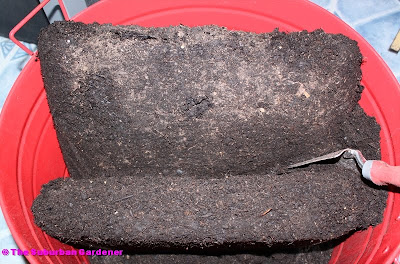For starters of this post are images of the bulbs that were planted yesterday. The crinums were not potted up. Since they thrive on neglect in the south, I think it would not bother them if I store them in a cool dry place until spring time when it is best for them to be planted. Most of my crinums are dormant anyway except for the Asiaticum and the Amarcrinums. They seem to like the heat of the grow lights or maybe they are the varieties that doesn't go through dormancy.
 Amaryllis Belladonna bulbs
Amaryllis Belladonna bulbs E. toulumnense bulbs
E. toulumnense bulbsLast spring, Mr.McGregor's Daughter posted some images of E. Pagoda flowers and I really liked them. The flowers are lily-like, and you all know that the genus Lilium is so dear to my heart. Some varieties have spotted leaves which is an added bonus to the beautiful flowers.

E. Kondo bulbs

E. albidum bulbs from eBay. I hope these are the real thing.

N. Amadeus Mozart bulbs

N. Winston Churchill bulbs

A block of frozen soil. I have to wait few hours before I can break it in half.

And overnight thawing is needed before the soil can be utilized.

Potted Belladonna topped with grits (aquarium pebbles, my version), which I've learned from Chris of Rooftop Horticulture.

The other Belladonna bulb. I have to get some more of the pink aquarium pebbles for this pot.

I checked the dates of the Hansonii baggie and a no tag one and they have spent three months in the fridge already. The scales were put in a damp peat moss, spent 3 months in dark warm place and then another 3 months in the fridge for vernalization. If my method is wrong, please correct me.

This is the lone Pardalinum bulblet.

Here is one of the Koures pots. Just how amazing a couple of days exposure to light has made the bulblets' first leaf turn green.

Having about fifty bulbs and bulblets of Lycoris radiata, I have to find a planter that will fit them all in. I am running out of space in the basement. I found this gift wrap container and thought this is the perfect planter. There is a perfect spot for it in the growing area. It measures 33 inches long, 8 inches deep and 12 inches wide.

Here is my messy growing area in the basement. Cybister Lima is sending up a scape and I am excited. I hope my other amaryllises will do the same.


I was outside today with my DD and took some pics from the garden. The next two were taken today and the rest were taken few days/weeks ago.

Azalea 'Maximum Roseum'

Rhodie 'Nova Zembla', a big box store rescue.

Bridal Wreath Spirea

When I started gardening, I was big on sedums. I had these plants for a few years now. I leave them outside in winter time just like how they are in this pic and they come back year after year.

There are four different kinds of groundcover sedums in this planter: Acre, Dragon's Blood, Ellacombianum and Angelina.
4 comments:
All erythroniums are in the lily family, but I have had varying luck with the various species. E. x 'Pagoda' (and look alike 'Kondo') grows and naturalizes for me here in SE PA as does E. dens-canis. However , I haven't had much luck with E. californicum 'White Beauty' or E. revolutum, which I have tried numerous times because I really want it. I finally gave up. Would love to know how yours turn out. I was growing them in the ground. Carolyn
Carol,
Thank you so much for the informations. It was my intention to plant them in the ground but it snowed the day I got these bulbs and more snow came so there is no chance to plant them in the ground now. I am glad they grow and naturalizes in PA. Hope they do the same here. Look like the species are hard to grow. I need to do some research on these plants. I will post some pix if they do live for me. Thanks again!
The Erythronium Pagoda grows very well in our woodland spot here in Scotland. They are also known as the dogtooth lily because of the bulb shape. It may just be a local name, I am not sure.
Alistair,
Dogtooth lily is the common name. I have been doing a little research about these plants. The interesting ones are from the Alpine Garden Society. Thanks for the visit.
Post a Comment